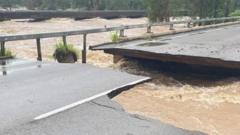Sections of a significant Australian highway, the Bruce Highway, have partially collapsed amid worsening flooding conditions in Queensland. The relentless rainfall across the state has already resulted in one fatality and has displaced thousands of residents, especially in areas such as Townsville, Ingham, and Cardwell, where the impacts have been severe. Weather forecasts indicate that record-breaking precipitation is set to persist, with some regions receiving over 1.3 meters (4.2 feet) of rain in just three days, leading to overflowing dams and rivers.
Prime Minister Anthony Albanese acknowledged the crisis’s impact after being briefed on emergency response strategies, stating that the disaster has demonstrated the resilience and support of Australians during this challenging time. He cautioned that flood threats will remain in the affected areas for several days as communities brace for potential worsening conditions.
Rescue operations have been hampered by the destruction of vital infrastructure, notably a bridge on the Bruce Highway, which connects Brisbane with regional centres and is longer than the road between London and Warsaw. The Queensland Trucking Association reported that this disruption could result in increased travel distances by 700 km (434 miles), complicating the delivery of essential supplies to flood-affected regions.
Ingham, one of the communities hardest hit, mourns the loss of a 63-year-old woman who tragically died during a rescue attempt when her State Emergency Service dinghy capsized. Queensland's Premier David Crisafulli expressed his condolences and announced plans to visit north Queensland to assess the situation. He urged residents in flood-impacted areas, known as the "black-zone," not to return home due to dangers posed by rising waters from the Ross River.
The Bureau of Meteorology reported that the affected area received six months' worth of rainfall in merely three days. As floodwaters continue to rise, the Townsville Local Disaster Management Group has warned that around 2,000 homes could be flooded, possibly up to their second floors. Even as the heavy rainfall begins to subside, extensive flood warnings remain in effect for various rivers, including the Hebert, Ross, Bohle, Horton, and Upper Burdekin.
Emergency services are working relentlessly, responding to hundreds of calls for help, with over 11 swift water rescues recorded in just one night. Many residents remain without power, hindering communication avenues, and around 400 people are currently housed in evacuation centres across the most affected regions.
As north Queensland grapples with tropical weather conditions prone to cyclones and flooding, climate experts warn that the consequences of a warming planet are leading to more frequent and intense rainfall events. Current meteorological assessments suggest that these floods may represent the worst the region has experienced in over six decades.




















